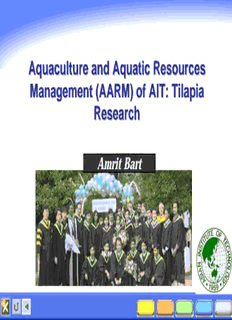
Aquaculture and Aquatic Resources Management (AARM) of AIT PDF
Preview Aquaculture and Aquatic Resources Management (AARM) of AIT
AAqquuaaccuullttuurree aanndd AAqquuaattiicc RReessoouurrcceess MMaannaaggeemmeenntt ((AAAARRMM)) ooff AAIITT:: TTiillaappiiaa RReesseeaarrcchh Amrit Bart BBaacckkggrroouunndd ! Although, historical evidence of fish culture dates back several centuries, global promotion of aquaculture is relatively recent ! The earlier academic programs in aquaculture started in the 60s and 70s with Auburn University(cid:146)s Department of Fisheries & Allied Aquacluture as one of the earliest lead institutions ! Over the last 40 years, aquaculture as a prominent discipline has become integral part of most large agricultural universities ! Curriculums and research have evolved to accommodate commercial and small-scale production systems BBaacckkggrroouunndd In line with increasing interest and the need to bolster aquaculture production- research based on science was becoming important in Asia The WFC and AIT were some of the earliest international institutions with a mission to improve production through science-based research Although, the AARM was established in 1981, research in aquaculture (in tilapia) started in the 70s ! Since then AARM has produced " Over 400 MSc and PhD grads " 1,500 trainees in aquaculture ! AARM Research themes in tilapia " Small-scale aquaculture " Seed production and genetics " Fish nutrition and feeding management Since 1981, it has produced over 150 peer reviewed publications on tilapia !An equal numbers of non-peer reviewed publications OObbjjeeccttiivveess !This presentation " Explores the historical accounting of some of the AARM publications related to tilapia research " This parallels the development of tilapia culture in many Southeast Asian countries EEvvoolluuttiioonn ooff TTiillaappiiaa ssttuuddiieess aatt AAIITT ! Tilapia as a model species for the utilization of sewage and other forms of human waste ! Then the use of animal manure and in small- scale integrated framing system ! Tilapia as a species to combat rural poverty The excitement over this species has been its low-input requirements for culture, its potential for rural farm consumption and its ability to recycle organic waste 11998811--11998855 ! The earliest paper was authored by Peter Edwards- on the harvest and utilization of microalgae from sewage fed ponds using tilapia (1983) ! Two years later (1985), another paper was published on the application of compost for tilapia feed ! A third of the similar paper in 1985- in the Aquaculture and Fisheries Management journal- The use of locally available composted and dried water hyacinth in pelleted feed of tilapia 11998866--11998899 ! About this time there were three parallel studies related to tilapia " Production optimization studies by improving primary production and husbandry practices (Diana, Lin) " Culture tilapia using human and animal wastes (Edwards) " Seed production and sex reversal tilapia using 17α (cid:150) methyltesterone and progesterone (Macintosh, Singh and Little) ! The diversity of topics during this period reflects new entrants, diversification of interests and the changing focus for tilapia research
Description: